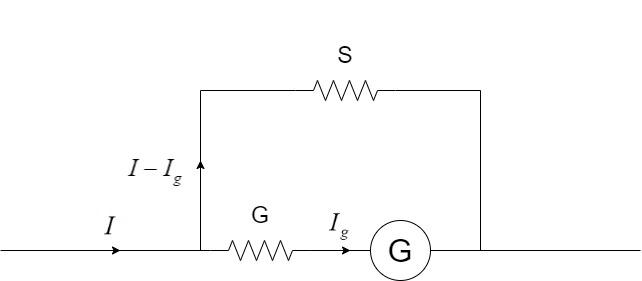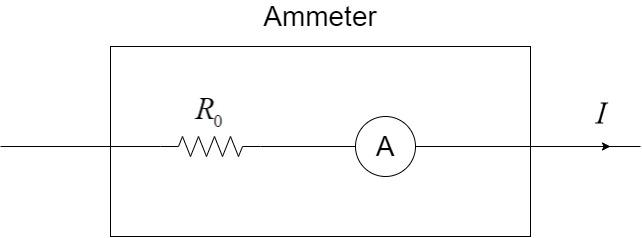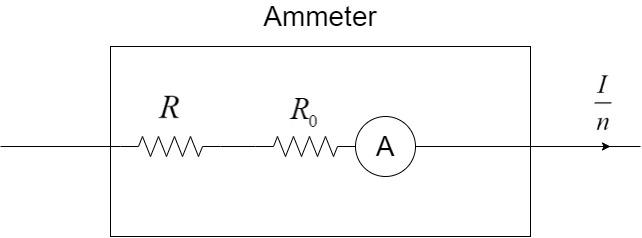Answer
64.8k+ views
Hint: To solve this question, we have to understand the arrangement in which a galvanometer can be converted to an ammeter. To convert a galvanometer to ammeter, a resistor of very low resistance called shunt resistance should be connected in parallel to the galvanometer.
Complete step by step solution:
An ammeter is a device used to measure the magnitude of current flowing through the wire. It is connected in the series with the branch in which current has to be measured.
An ammeter can be constructed from a galvanometer by connecting a low resistance in parallel to the galvanometer as shown:

If G is the resistance of the galvanometer, $I$ is the current to be measured and ${I_g}$ is the current flowing through the galvanometer, the value of shunt resistance connected to the galvanometer is given by –
$S = \dfrac{{G{I_g}}}{{I - {I_g}}}$
Thus, the complete setup can be summarised as the schematic figure of an ammeter with a resistance which is given here, as ${R_0}$ with the current I flowing through the ammeter.

Let R be another resistance connected in series with ${R_0}$ such that the current flowing through the ammeter shall be $\dfrac{I}{n}$ as shown:

In both the cases, the voltage drop across the ammeter remains constant since the current flowing is the same in both the cases.
Voltage drop in the first case: $V = I{R_0}$
Voltage drop in the second case: $V = \dfrac{I}{n}\left( {R + {R_0}} \right)$
Equating them, we get –
$I{R_0} = \dfrac{I}{n}\left( {R + {R_0}} \right)$
$ \Rightarrow {R_0} = \dfrac{{R + {R_0}}}{n}$
$ \Rightarrow n{R_0} = R + {R_0}$
$ \Rightarrow R = n{R_0} - {R_0}$
$ \Rightarrow R = {R_0}\left( {n - 1} \right)$
Hence, the correct option is Option B.
Note: The students must note the fact that in an ammeter, the shunt resistor used, has a very low value, usually in micro- or milli- ohms. If you encounter any problem on calculating the shunt resistance in an ammeter and you do not get a low resistance, it is sure that the solution is headed in the wrong direction.
Complete step by step solution:
An ammeter is a device used to measure the magnitude of current flowing through the wire. It is connected in the series with the branch in which current has to be measured.
An ammeter can be constructed from a galvanometer by connecting a low resistance in parallel to the galvanometer as shown:

If G is the resistance of the galvanometer, $I$ is the current to be measured and ${I_g}$ is the current flowing through the galvanometer, the value of shunt resistance connected to the galvanometer is given by –
$S = \dfrac{{G{I_g}}}{{I - {I_g}}}$
Thus, the complete setup can be summarised as the schematic figure of an ammeter with a resistance which is given here, as ${R_0}$ with the current I flowing through the ammeter.

Let R be another resistance connected in series with ${R_0}$ such that the current flowing through the ammeter shall be $\dfrac{I}{n}$ as shown:

In both the cases, the voltage drop across the ammeter remains constant since the current flowing is the same in both the cases.
Voltage drop in the first case: $V = I{R_0}$
Voltage drop in the second case: $V = \dfrac{I}{n}\left( {R + {R_0}} \right)$
Equating them, we get –
$I{R_0} = \dfrac{I}{n}\left( {R + {R_0}} \right)$
$ \Rightarrow {R_0} = \dfrac{{R + {R_0}}}{n}$
$ \Rightarrow n{R_0} = R + {R_0}$
$ \Rightarrow R = n{R_0} - {R_0}$
$ \Rightarrow R = {R_0}\left( {n - 1} \right)$
Hence, the correct option is Option B.
Note: The students must note the fact that in an ammeter, the shunt resistor used, has a very low value, usually in micro- or milli- ohms. If you encounter any problem on calculating the shunt resistance in an ammeter and you do not get a low resistance, it is sure that the solution is headed in the wrong direction.
Recently Updated Pages
Write a composition in approximately 450 500 words class 10 english JEE_Main

Arrange the sentences P Q R between S1 and S5 such class 10 english JEE_Main

What is the common property of the oxides CONO and class 10 chemistry JEE_Main

What happens when dilute hydrochloric acid is added class 10 chemistry JEE_Main

If four points A63B 35C4 2 and Dx3x are given in such class 10 maths JEE_Main

The area of square inscribed in a circle of diameter class 10 maths JEE_Main

Other Pages
A boat takes 2 hours to go 8 km and come back to a class 11 physics JEE_Main

Electric field due to uniformly charged sphere class 12 physics JEE_Main

In the ground state an element has 13 electrons in class 11 chemistry JEE_Main

According to classical free electron theory A There class 11 physics JEE_Main

Differentiate between homogeneous and heterogeneous class 12 chemistry JEE_Main

Excluding stoppages the speed of a bus is 54 kmph and class 11 maths JEE_Main



